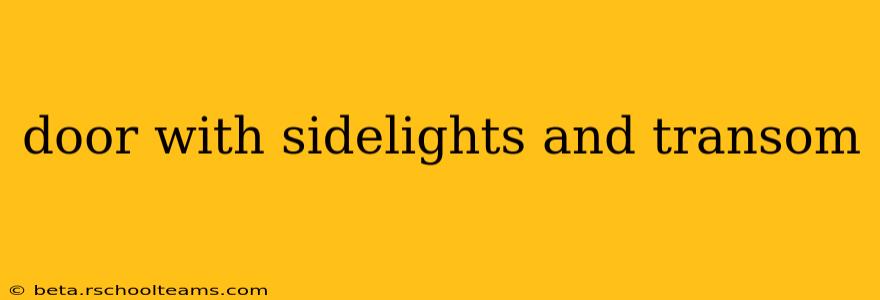A door with sidelights and a transom is more than just an entrance; it's an architectural statement. This elegant design element adds character, style, and often, increased natural light to any home. But choosing the right one involves considering several factors beyond just aesthetics. This guide will walk you through everything you need to know about doors with sidelights and transoms, answering your most pressing questions and helping you make an informed decision.
What is a Door with Sidelights and Transom?
A door with sidelights and a transom features vertical windows (sidelights) flanking the main door and a horizontal window (transom) above it. This combination creates a visually appealing and often larger opening, maximizing light penetration and enhancing the curb appeal of your home. The sidelights and transom can be made from various materials, including glass, wood, and even metal, offering a wide range of design options to complement your home's style.
What are the Benefits of a Door with Sidelights and Transom?
The advantages extend beyond simple aesthetics:
- Increased Natural Light: The primary benefit is the significant increase in natural light entering your home. This reduces the need for artificial lighting during the day, saving energy and creating a brighter, more welcoming interior.
- Enhanced Curb Appeal: A door with sidelights and a transom instantly elevates the exterior of your home, adding a touch of elegance and sophistication. It can significantly improve your home's overall visual appeal and market value.
- Improved Security (with proper glazing): While glass may seem less secure, modern laminated or impact-resistant glass options offer excellent security features, providing a sturdy barrier against intruders.
- Architectural Detail: This type of door adds architectural interest and depth to your entryway, creating a focal point that draws the eye.
- Increased Home Value: As mentioned, the upgrade significantly increases your home’s value, making it a worthwhile investment.
What are the Different Types of Glass Used in Sidelights and Transoms?
The type of glass you choose impacts both aesthetics and functionality:
- Clear Glass: Offers maximum light transmission, providing the brightest interior.
- Frosted Glass: Provides privacy while still allowing some light to filter through.
- Textured Glass: Adds visual interest with various patterns and textures.
- Obscured Glass: Offers more privacy than frosted glass, while still allowing diffused light.
- Laminated Glass: A safety feature, it's made of multiple layers bonded together, making it more resistant to breakage and offering better security.
- Impact-Resistant Glass: The strongest option, it withstands impacts and provides superior security.
How Much Does a Door with Sidelights and Transom Cost?
The cost varies significantly depending on several factors:
- Door Material: Solid wood doors are typically more expensive than fiberglass or steel doors.
- Glass Type: The type of glass used (clear, frosted, laminated, etc.) will influence the price.
- Size and Dimensions: Larger doors with wider sidelights and transoms will naturally cost more.
- Customization: Custom designs and finishes will add to the overall cost.
- Installation: Professional installation is recommended and adds to the final expense.
Expect to pay anywhere from a few hundred dollars for a basic model to several thousand for a high-end, custom-designed door.
What are the Common Styles of Doors with Sidelights and Transoms?
The style of your door should complement your home's architecture:
- Traditional: Often features raised panels, intricate molding, and classic glass patterns.
- Modern: Characterized by clean lines, minimalist designs, and large expanses of glass.
- Craftsman: Emphasizes natural materials, handcrafted details, and often incorporates stained glass.
- Farmhouse: Features simple designs, often with rustic hardware and clear or frosted glass.
How Do I Choose the Right Size Door with Sidelights and Transom?
Consider the following:
- Doorway dimensions: Measure your existing doorway carefully to ensure a proper fit.
- Available space: Ensure you have enough space on either side of the door for the sidelights to open without obstruction.
- Interior layout: Consider how the door and sidelights will affect the flow of your interior space.
How Difficult is it to Install a Door with Sidelights and Transom?
Installing a door with sidelights and transom is a complex project best left to experienced professionals. While DIY is possible for some, the precision required to ensure proper alignment, sealing, and functionality makes professional installation highly recommended.
This comprehensive guide offers a starting point for understanding doors with sidelights and transoms. Remember to consult with a professional contractor for personalized advice and accurate cost estimations based on your specific needs and location.
